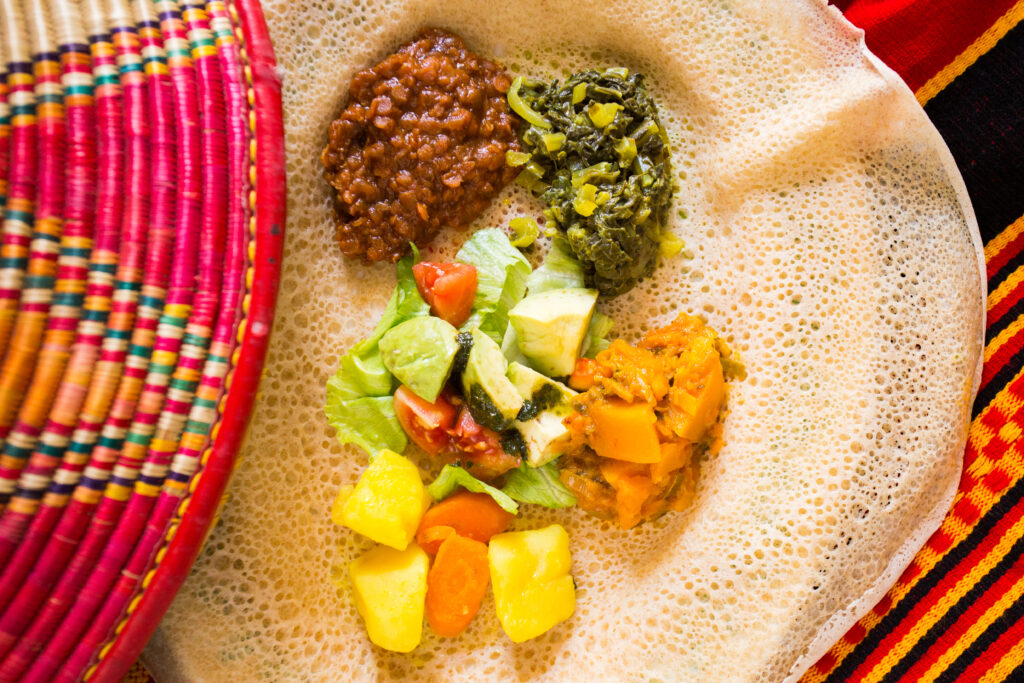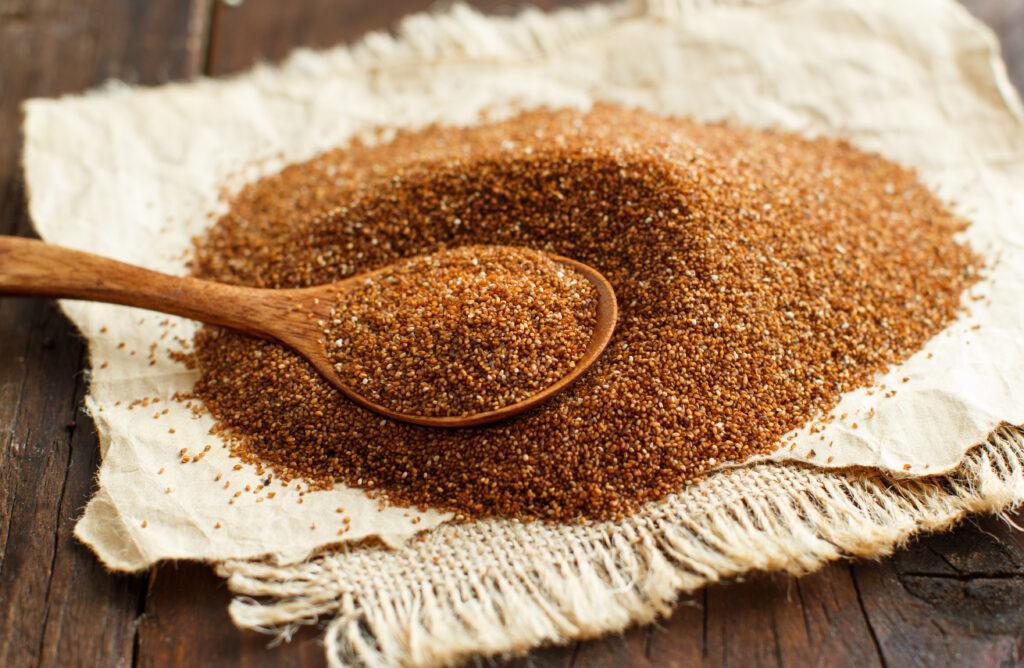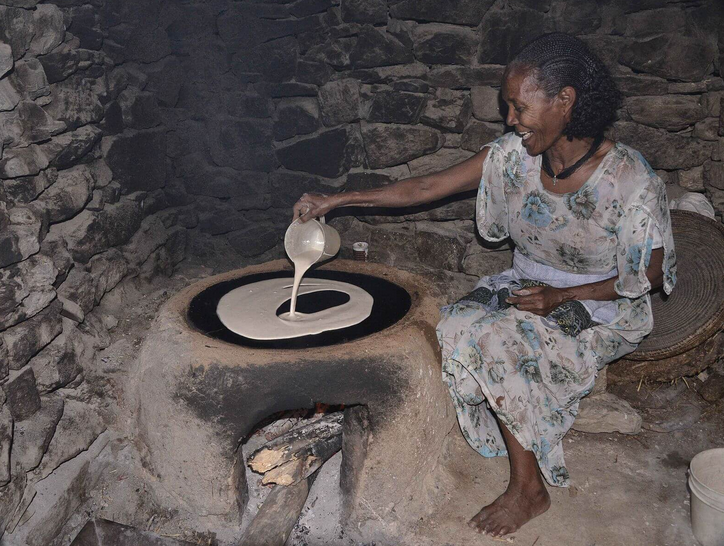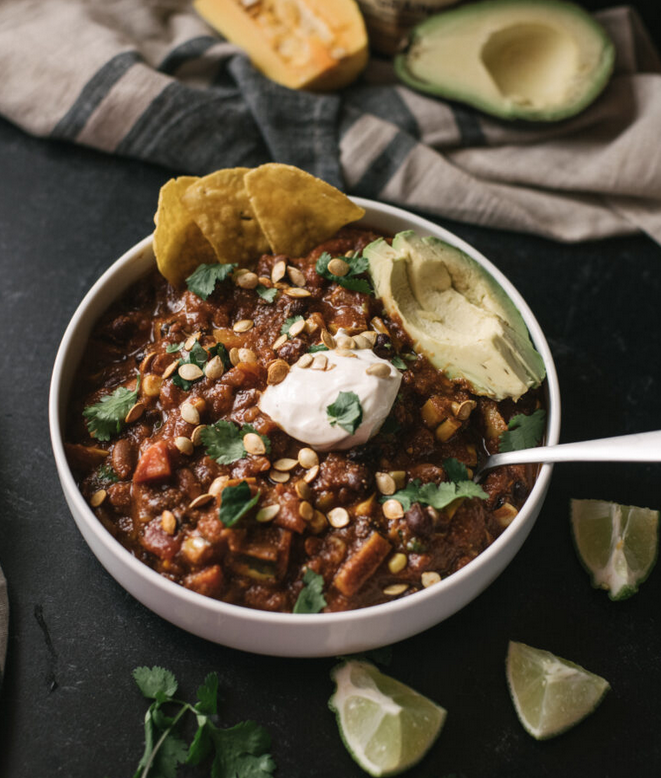
Many Americans had their first “taste” of teff—Ethiopia’s ancient cereal staple– through the writing of Abraham Verghese, MD, the beloved Stanford surgeon who authored the 2009 novel, Cutting for Stone.
The story begins in Verghese’s childhood homeland of Ethiopia, and in it, the author describes his love of injera, the traditional sourdough flatbread made from teff.
“The delectable red chicken curry, doro-wat, came poured onto the soft crepelike injera used to scoop up the meat…her mouth watered just thinking of the dish”.
If you’ve ever eaten in an Ethiopian restaurant, you’ve already experienced the distinct flavor and texture of bread made with this unique, gluten-free grain.
Injera is created from stone-ground teff flour, which is naturally fermented over the course of several days, then poured like pancake batter onto a large, heated stone and cooked until bubbles appear. It has a porous, spongy, pancake-like texture, and it serves as both plate and utensil for eating the rich, spiced stews that are the mainstays of Ethiopian cuisine.
If you haven’t had the pleasure, you owe it to yourself to make a field trip to the best Ethiopian restaurant you can find.
As an intact seed, it is naturally high in fiber with a low glycemic index, making it an excellent grain for stabilizing blood sugar and helping to prevent and control diabetes and heart disease.
Heirloom Gluten-Free Grain
Injera may be the best-known incarnation of teff, but there’s far more to this heirloom grain. It makes a wonderfully satisfying breakfast porridge, and it can be used in a variety of breads, muffins, and pastries. Among the peoples of the Horn of Africa, it is sometimes mixed with chickpeas or soybeans. It can be brewed into a variety of alcoholic drinks, and it is also an important source of animal fodder.

Teff (Eragrostis tef) is indigenous to Ethiopia and Eritrea, where it has served as the daily staple for roughly 90 million people for thousands of years. It is a stress-tolerant, fast-growing cereal grain that is still cultivated using ancient farming methods.
But those methods are inefficient in that a significant percentage of the tiny grains—roughly the size of poppy seeds—are lost. In fact, the Amharic word tef, actually means “lost”.
Teff has been growing in international popularity in recent decades, as health-conscious consumers seek out ever more gluten-free options. Consequently, its price has soared. The situation was further compounded in 2006, when the Ethiopian government banned international exports for almost a decade, fearing the surging worldwide demand would cause food insecurity within Ethiopia, as was experienced in South American countries when quinoa, their local staple, became an international culinary superstar.
In response to the global shortage, farmers in India, China, Australia, and the US have begun to cultivate teff. It is now grown commercially in California, Oregon, Oklahoma, Kansas and Idaho and is available as a certified gluten-free product by dedicated US farmers.
Several companies, including the popular Bob’s Red Mill and The Teff Company are ensuring a steady supply of the grain for American shoppers.
Business has been booming since the COVID pandemic, says T. J. Anderson, of the Boise, ID-based Teff Company, in a video interview. With international supply chains disrupted, Ethiopian communities in the US suddenly found themselves reliant on domestic producers. And with many more people at home, experimenting in the kitchen, a new wave of Americans have discovered the grain in their quest to try new things.
According to the Whole Grains Council, the number of products using teff has doubled in recent years.
A Nutritional Powerhouse
Though teff is the smallest of all the cereal grains, measuring less than 1 mm in diameter, it boasts an impressive nutritional profile.
As an intact seed, it is naturally high in fiber with a low glycemic index, making it an excellent grain for stabilizing blood sugar and helping to prevent and control diabetes and heart disease.
But it is the protein content of teff that makes it an essential part of the Ethiopian diet: teff contains all 9 essential amino acids due to its relative higher lysine content. While the exact complete protein content is under debate, one quarter cup (4 oz) of the cooked grain provides approximately 4-6 grams of complete protein (Gebru et al. Foods 2019).
Teff is also rich in iron, calcium, zinc, copper and manganese. Just ¼ cup provides 100% of the daily value of manganese.
Three varieties of teff exist: one with light linen color, another with a red hue, and a darker-brown variety. The latter appears to be richer in phytonutrients than the lighter colored varieties.
Because teff is closely related to millet, another gluten-free cereal grain, it is sometimes referred to as “teff millet”.
According to researchers in India who studied the nutrients in teff, “Phytochemical analysis indicated the presence of flavonoids, saponins, tannin, glycosides, and steroids. The study showed that teff millet has high antioxidant activity…Therefore, it can be beneficial for celiac disease, hypertension, anemia, diabetes, and cancer condition. The development of food products incorporated by teff millet as a nutraceutical food can improve health and prevent different disease and disorders.” (Chauhan A, IJPSR, 2020).

Fermentation of teff, as is done in the preparation of injera, increases the bioavailability of the phenolic compounds and antioxidants. It also creates a pleasing, slightly tart taste, like sourdough breads in the west.
Bread baked from unfermented teff flour is high in dietary fiber, minerals, and phytochemicals such as the phenolic compounds protocatechuic, vanillic, syringic, p-coumaric, sinapic, ferulic, and rosmarinic acids; catechin; and naringenin. However, the phytic acid content can be a concern.
According to researchers at the University of Ghent, fermentation of teff for 72 hours, increased the majority of soluble phenolic compounds by anywhere from 42–1805%, while decreasing insoluble phenols by 2–100% (Shumoy H, Raes K. Cereal Chem. 2016). They also note that the brown varieties of teff (Zagurey and Zezew) showed superior total phenolic and antioxidant contents compared to the white varieties (Quncho and Tsedey).
Culinary Considerations
Teff has a mild, nutty flavor with hazelnut, cocoa, and buckwheat undertones. It is satisfying when cooked as a porridge and served with a sprinkle of cinnamon, cloves, maple syrup, or dates and toasted nuts. Because the seeds are so tiny, they cling together, forming a creamy porridge that can be cooled to form into a cake, like polenta.

Teff can also be turned into a savory “pilaf” by dry toasting for 2-3 minutes until the grains start to pop, then simmering it in broth and tossing with chopped fresh herbs, roasted veggies, toasted nuts and olive oil.
Mixing teff with quinoa or millet will create a lighter, fluffier texture and color.
If you’re feeling really adventurous in the kitchen, you can try your hand at making injera. Kalkidan Tesfu’s Injera for Beginners video will take you through the process, in both English and Amharic, giving non-Ethiopian viewers an opportunity to hear the tones and textures of this ancient language. Chef Sebla offers a quicker version that uses beer for fermentation, though if you make this version, the injera will no longer be gluten-free.
The Teff Company’s website offers a wide variety of fantastic recipes to help you (and your patients) create delicious, healthy meals centered around teff. These include Sweet Potato Teff “Meat”balls, slow-cooked Teff Chili with Delicata Squash, and Vegetable Pot Pie with Teff Crust.
The Whole Grains Council also has some great suggestions, including a Coconut Curry Teff & Vegetable Stew.
And, in the healthier snacks department, a California-based, woman-owned company called Blue Nile Living recently introduced teff chips into the market.
However you use it, you’ll find that teff is a versatile, flavorful and nutritious addition to your culinary repertoire.
Sally LaMont, ND, LAc, is a naturopathic doctor and acupuncturist with over 30 years of experience in functional medicine. She practices at the Marin Natural Medicine Clinic in Larkspur, CA, and specializes in a range of digestive problems, thyroid, adrenal and female hormonal imbalances, brain fog and early dementia, and other chronic diseases.
Dr. LaMont earned her ND in 1981 from the National University of Naturopathic Medicine and her Master of Science in Oriental Medicine in 1986 at Emperor’s College of Traditional Chinese Medicine. She completed advanced training in The Bredesen Protocol to Prevent and Reverse Cognitive Decline through the Institute for Functional Medicine and the Buck Institute of Aging.
As Executive Director of the California Naturopathic Doctors Association, Dr. LaMont led the successful legislative campaign to license naturopathic doctors (NDs) in California. Her love of cooking and firm belief in food as medicine inspired her newest project, Dr. Sally’s Kitchen, an educational website offering “Rx Recipes” and “Food Pharmacy” guidance for patients and practitioners alike.







